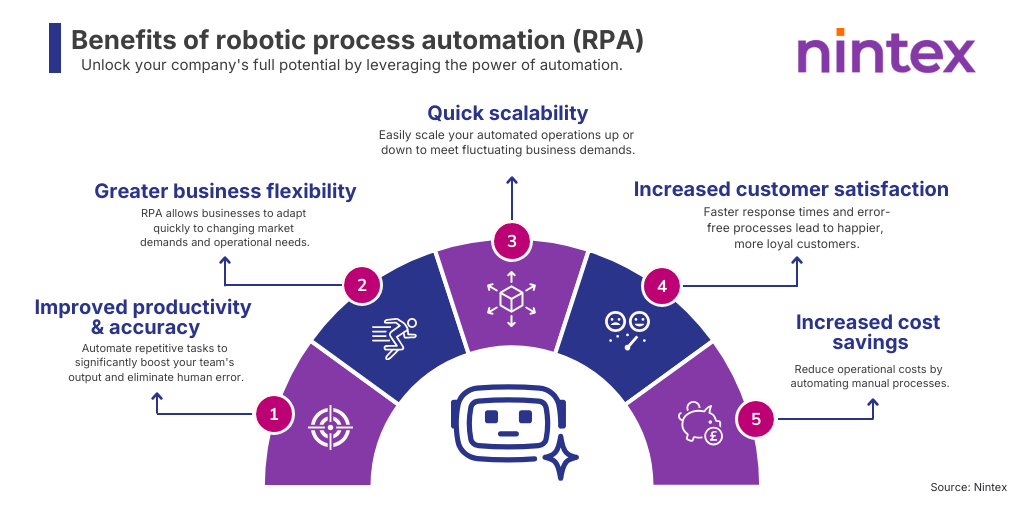Today’s organizations are burdened by complex, high-volume processes, often impacting their ability to effectively focus on the core business. What could a company achieve if employees focused on innovative, results-driven work, instead of completing thousands of repetitive, manual processes each day, impacting everything from operational costs to customer satisfaction?
Robotic Process Automation (RPA) is one of the easiest projects for a CIO to greenlight that helps to address the issue. Relatively inexpensive, with a high ROI, it is a tangible cost-out scenario that is easy to understand: take humans out of a process, add in virtual software ‘robots’ that do it faster, 24/7 with fewer errors, and then redirect employees to more valuable and satisfying work. Businesses save on headcount, time, and error triage while employee job satisfaction soars.
Robotic Process Automation definition
Robotic Process Automation (RPA) is a technology that lets businesses replace human intervention in repetitive tasks with virtual software “robots.” The solution results in cost and time efficiency, as well as increased job satisfaction by allowing employees to focus on higher value tasks.
Understanding Robotic Process Automation
According to Deloitte Global, a Fortune 1000 organization with $20 billion revenue and 50,000 employees, automating 20% of estimated addressable activity with RPA could result in more than $30 million of bottom-line impact each year.
McKinsey Global Institute states, “Not only is the adoption of RPA increasing, it is expected to have massive economic influence. In addition to creating more jobs, the technology will have a potential economic impact of $5.2 billion.
In the applications we sized, we estimate that knowledge work automation tools and systems could take on tasks that would be equal to the output of 110 million to 140 million full-time equivalents (FTEs). It is possible that this incremental productivity—which does not include any estimate of the value of higher quality output due to better knowledge tools—could have as much as $5.2 trillion to $6.7 trillion in economic impact annually by 2025.”
This simple concept has led to incredible growth in RPA.
Gartner, a technological research firm, says 96% of customers are seeing significant value from RPA. PWC says $2 trillion is out there in savings, ready for the RPA-taking, representing 46% of work.
What is Robotic Process Automation (RPA)?
In the simplest terms, RPA is an intelligent automation solution that allows businesses to create a virtual software robot workforce that performs repetitive tasks just as a human would, freeing human employees from mundane, repetitive work. Think about manually transferring data from one software application to another – a mind-numbing daily need that is rife with opportunity for errors.
RPA enables businesses to create distinct virtual workforces that drive speed, agility, and efficiency and can take over those repetitive tasks. But the potential for RPA is greater than just one task. RPA stands out for its ability to positively impact outcomes business-wide by providing efficient ways to carry out processes across the organization, resulting in significant ROI.
What is RPA software?
RPA is a virtual workforce comprised of software robots that can execute business tasks in and across applications, becoming an integral part of a business’s workforce. The virtual workforce is managed just as any other team in the organization and can operate in the background without human intervention or interact with people to complete tasks. The robots complete business processes, just as a person would, but in less time, with greater accuracy, and at a fraction of the cost. In fact, one RPA robot can do the work of 3 to 5 full time employees because the robots can work 24/7/365.
RPA is used for automating and optimizing repetitive, time-consuming manual tasks, such as populating spreadsheets, generating reports, monitoring inventory, and even more complex actions such as employee training and compliance. With repetitive tasks taken care of by the bots, employees can focus on more strategic, creative, and high-value tasks that drive innovation and customer satisfaction.
According to the Institute for Robotic Process Automation and Artificial Intelligence (IRPAAI), almost any organization that has many different, complicated systems that need to mesh together is a good candidate for RPA. In fact, across nearly every industry – finance, insurance, healthcare, legal, manufacturing, retail, banking and utilities, and others – RPA is used to create virtual workforces to automate burdensome, high volume, and time-consuming business processes.
Benefits of Robotic Process Automation (RPA)
What are the benefits of RPA? By driving business agility and productivity, RPA benefits the entire organization, from data entry to sales efficiency. Some of the benefits of robotic process automation are:

Greater business flexibility
Scale your virtual workforce quickly and easily. RPA allows for rapid change response and quick deployment when business needs arise.
Improved employee satisfaction
Employees who would otherwise spend a large amount of time on rote, mundane, and repetitive tasks can use their skills to accomplish more challenging and business critical work.
Increased cost savings
RPA saves costs by reducing valuable time spent by employees on mundane, repetitive tasks, and decreasing FTE workforce needs. And by improving accuracy, the bots eliminate time and cost-intensive corrections and re-work.
Quick scalability
RPA operations can be scaled up quickly and easily. Users can add, change, or expand automation processes as needed without incurring downtime.
Increased accuracy
Eliminate human oversight by assigning robots to error-prone processes such as procure-to-pay, quote-to-cash, and claims processing. By reducing how often employees input data manually, you decrease the risk of human error and improve accuracy.
Increased customer satisfaction
For customer service, automating the repetitive tasks that consume representatives’ attention empowers them to get more done in less time – so they can minimize their average handling time and offer more personalized service. Better service experiences mean happier customers.
Improved productivity
Execute unlimited processes with a single robot, including during peak periods. One bot can handle the work of 3 to 5 full time employees and can complete more tasks faster without interruption.
Decreased operational costs
Cut in-house or outsourced workforce and training expenses by offloading mundane, repetitive tasks to virtual robots that never clock out. Free up your team for more strategic work and save valuable time.
Improved speed and efficiency
Bots work around the clock at digital speeds. What once took a team of people and hours of effort is now handled by RPA bots in minutes, moving from task to task with no down time.
What is the future of RPA?
In 2022, Gartner reported the emergence of ‘hyperautomation’. This is the idea that businesses are seriously scaling up their approach to automating workplace processes, finding many more opportunities to automate tasks that were once the exclusive domain of human workers. Rapid advances in Artificial Intelligence (AI) are making this aspect of the digital transformation journey more accessible for many businesses.
AI is taking RPA to the next level, making it better – and smarter – than ever before. Assertions of RPA as a simple solution that can’t learn or handle complex thinking are no longer accurate.With technologies such as computer vision, optical character recognition (OCR), speech recognition, natural language processing (NLP), machine learning, and deep learning, AI is making it possible to automate processes that were once unsuitable for automation, including those requiring complex decision-making.
For example, AI technologies such as OCR and NLP can turn unstructured data like emails, PDFs, and handwriting into a structured format that can be read and processed by RPA robots. Machine learning can be used to identify patterns and make predictions about process outcomes, enabling RPA to prioritize tasks.
This is good news for businesses looking to move forward in their digital transformation journey. But which processes should they automate? And why?
The answer can be found in process discovery.
In simple terms, process discovery is the prequel to RPA. Process discovery identifies which processes are suitable candidates for automation by identifying, mapping them and ranking the best tasks for automation.
Because process discovery captures real-time, real-world data from employee desktops in live applications, AI advancements in computer vision, OCR, and machine learning will improve the automation’s ability to see, map, and collect data. Better bots = more accurate results.
Advancements in AI technology, process discovery, and RPA will mean the automations can identify and improve processes within — and across — your systems without human intervention. That means your organization will be able to do more than automate processes: It will be able to get in front of them entirely.
With the emergence of more advanced AI-powered tech, it will be possible to automate more processes and more complex tasks within those processes. And this is changing the future of work process automation before our eyes.
Problems & solutions
| Common challenges | Solutions |
|---|---|
| Employee resistance to change | Encourage collaboration and communication |
| Misunderstandings about RPA capabilities | Provide thorough training and resources |
| Technical integration issues | Conduct detailed workflow analysis |
| Misaligned expectations | Set clear goals and maintain open communication |
| Compliance risks | Implement automated processes for accuracy |
Key takeways
Robotic process automation (RPA) uses virtual robots to complete repetitive, manual tasks. It helps businesses save time, cut costs, and allow employees to focus on higher-value work.
- Organizations using business process automation software can see significant returns, such as lower operational costs, better accuracy, faster execution, and higher employee and customer satisfaction.
- AI allows RPA to handle more complex tasks like reading documents or understanding language, helping bridge the gap between RPA and intelligent process automation (IPA).
- RPA helps automate tasks in areas like customer service, HR, finance, and inventory, and scales quickly to meet enterprise-level needs.
FAQ
Q. What is RPA?
A. RPA is technology that automates repetitive tasks with software robots.
Q. How does RPA differ from traditional automation?
A. RPA is more user-friendly and requires minimal coding compared to traditional automation.
Q. Which industries benefit from RPA?
A. Finance, healthcare, and retail are just a few industries that see improved efficiency and accuracy with RPA.
Q. Can RPA integrate with existing systems?
A. Yes, solutions like those from Nintex integrate seamlessly with current software systems.
Q. What are the key benefits of RPA?
A. Cost savings, enhanced efficiency, improved accuracy, and increased employee productivity are key benefits.
